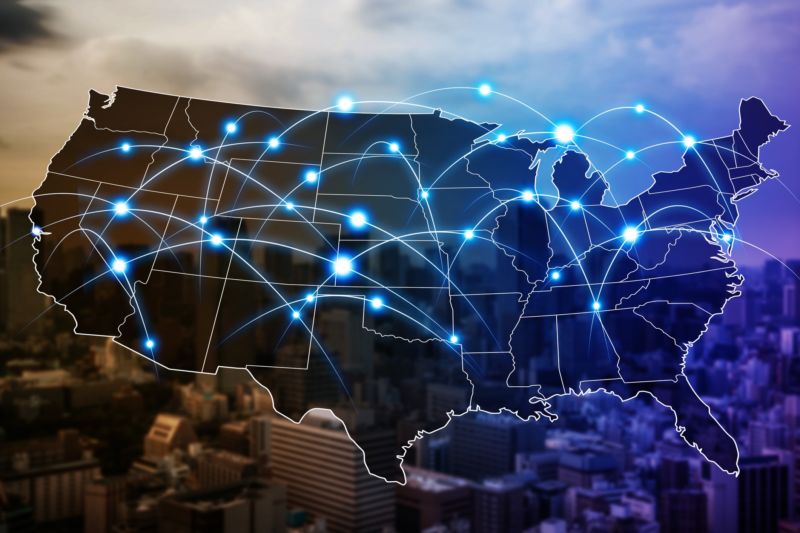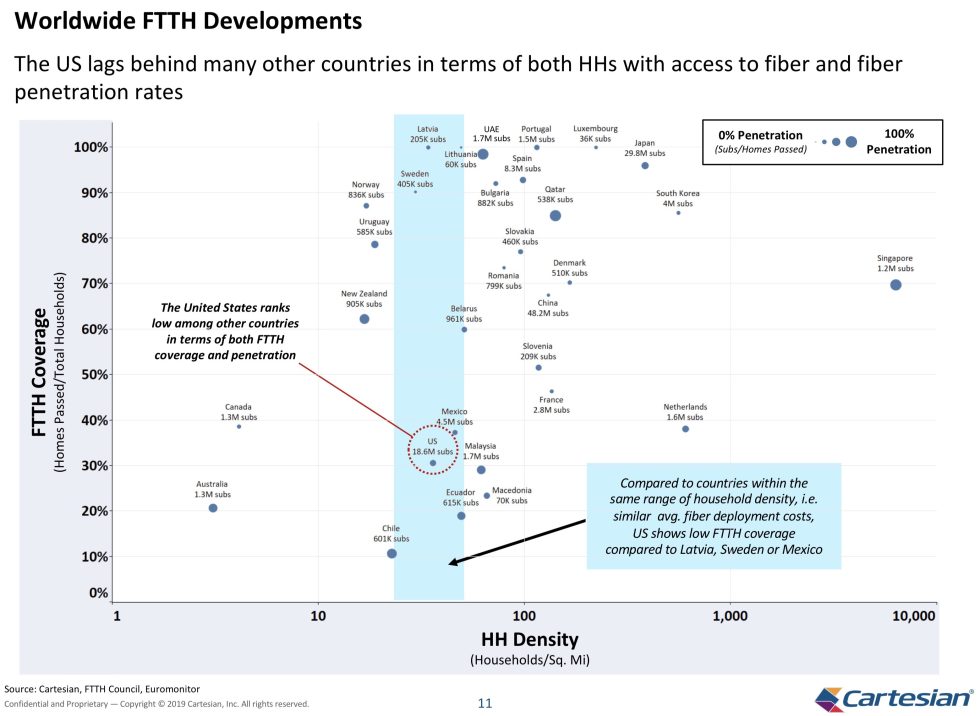Not enough fiber –
A cool $ 70 billion could help get the US to 90% fiber coverage, study says.

Fiber broadband is now available to more than 30% of households across the US, and fiber networks should reach 50% of homes by 2025, a new study says.
But 50% coverage would, obviously, leave another 50% of homes without access to the fastest wireline broadband technology. Reaching 80% of homes instead of just 50% would require an additional cash infusion of $ 52 billion over the next 10 years, the study says. Going from 80% to 90% would then require another $ 18 billion. Going from 90% to
% would be far more cost-prohibitive because it would require wiring up the least populated parts of the country, which make up “the vast majority of US land,” the study said.
The study was commissioned by the Fiber Broadband Association, whosemembersinclude municipal broadband providers, private ISPs such as Verizon and Sonic, and various vendors that sell equipment to the broadband industry. The industry group hired consulting firm Cartesian to conduct the study and submitted it to the Federal Communications Commission last week (see full study).
At 30% of homes, US fiber access is far behind numerous other countries, the report said. Spain, Portugal, Japan, and others are above 90, while countries such as Norway and South Korea are above 80%.
Currently, 39 .2 million households out of 127 .6 million in the US are passed by all-fiber networks, the study said. At the current pace, “by 2025, an estimated 25 .9 million additional households will be passed for a total of 65 .1 million — about 50% of US households, “the study said. There were just 12 .2 million households passed by fiber in 2008, but there have been steady improvements each year since.
Much of the increase came in the past four years due to AT&T deploying fiber to 12 .5 million customer locations. That was part of a government-required project thatAT&T agreed toin 2015 in exchange for approval to buy DirecTV. That buildout is nowfinished.
The latest FCC data suggests that 21 .3 million Americans lack access to fixed broadband with speeds of at least 25 Mbps down and 3Mbps up. Fiber offers much faster speeds and generally provides uploads that are as fast as downloads. The FCC hasordered ISPsto submit more accurate data, which could reveal even bigger broadband gaps.
US lags behind
Fewer than half of the 39 .2 million US households passed by fiber subscribe to a fiber service. The study said that 18 .6 million households in the US have a fiber broadband subscription.
The US has many rural areas with low housing density, which helps explain the shortage of fiber coverage — it’s more profitable to wire up densely populated cities where there are more potential customers. But fiber isn’t universally deployed through big cities either, as the industry report projects that 33 .9 million households in densely populated urban and suburban areas still won’t be covered by fiber in 2025.
The report also found that the US is lagging behind some other countries that have similar density in terms of households per square mile. Countries of similar housing density that have higher fiber deployment rates than the US include Latvia, Sweden, and Mexico, the report shows in this chart:

Enlarge/Chart from All-Fiber Deployment Cost Study.
Fiber Broadband Association
The y -axis in the above chart shows the percentage of homes covered by fiber in each country, while the x-axis shows density in households per square mile. The figures next to each country show the number of fiber subscribers.
The chart includes about 30 Countries. When contacted by Ars, the Fiber Broadband Association said the study “covered countries with [at least] 200, 000 households and at least 1 % FTTH [fiber-to-the-home] penetration. We further filtered to include the top countries by percent of households subscribed to fiber, and excluded any where penetration data was unavailable. The US would look better if we did include countries with lower fiber penetration, but we felt this was a representative sample of developed (Canada, New Zealand, Norway, Japan) and developing countries (China, Chile). “
Tens of millions stuck with cable or DSL
The US ‘fiber shortage has left tens of millions of Americans with cable as their only choice for high-speed broadband.Another study released last yearfound that Comcast is the only choice for 30 million Americans when it comes to broadband speeds of at least 25 Mbps downstream and 3Mbps upstream, and that Charter is the only choice for 38 million Americans. It’s even worse in areas that don’t have cable and have to rely on DSL for wired access.
Despite the clear need for expanded fiber access, the FCC and big telecom companies have spent more time hyping 5G, which isn’t likely to fill rural broadband gaps. Outside densely populated areas,5G will essentially be like “good 4G,” Verizon said recently. Even 4G hasn’t been fully deployed, as there are parts of the USwithout good cellular data coverage.
Expanding fiber access would dramatically improve home Internet service, and it could help fill some of those mobile broadband gaps, since cellular networksrely on fiber lines for bandwidth.
The FCC’s Connect America Fund has been giving money to ISPs to deploy rural broadband since 2011, but it has mostly focused on providing lower-speed broadband instead of fiber. FCC Chairman Ajit Pai is proposing to continue the fundingwith $ 20 .4 billion over (years) , and to use at least some of that to deploy fiber networks capable of delivering gigabit speeds. But the new money could also be used for non-fiber networks as long as theymeet the 25 Mbps download and 3Mbps upload standards. In all, the FCC says this will connect at least 4 million homes and small businesses that lack modern broadband service.
ISPs want more money
Last year, broadband lobby groups urged the FCC togive more money to ISPs, arguing that the “private-led investment model” only works well in “reasonably populous areas.”
Pai’s FCC in November 2017approved a deregulatory orderthat could make it easier for ISPs to turn off old copper networks even if they haven’t been upgraded to fiber. Consumer advocacy group Public Knowledge issuing the FCCto restore the Obama-era rules that were designed to protect consumers from losing service when copper phone networks are retired.
The Fiber Broadband Association says it’s hopeful that the US will spend enough money to go well beyond the 50% fiber coverage projected in its report. “Building all-fiber networks throughout America is not a pipe dream,” Fiber Broadband Association CEO Lisa Youngers said in a press release. Government funding and “innovative deployment models” can close the gap, she said.
“We have long known that having access to all-fiber networks is far superior than other technologies in driving economic growth, social interaction, and political engagement, “Youngers said. “Now we know that deploying all-fiber networks to most parts of the country within the next decade is feasible.”







GIPHY App Key not set. Please check settings